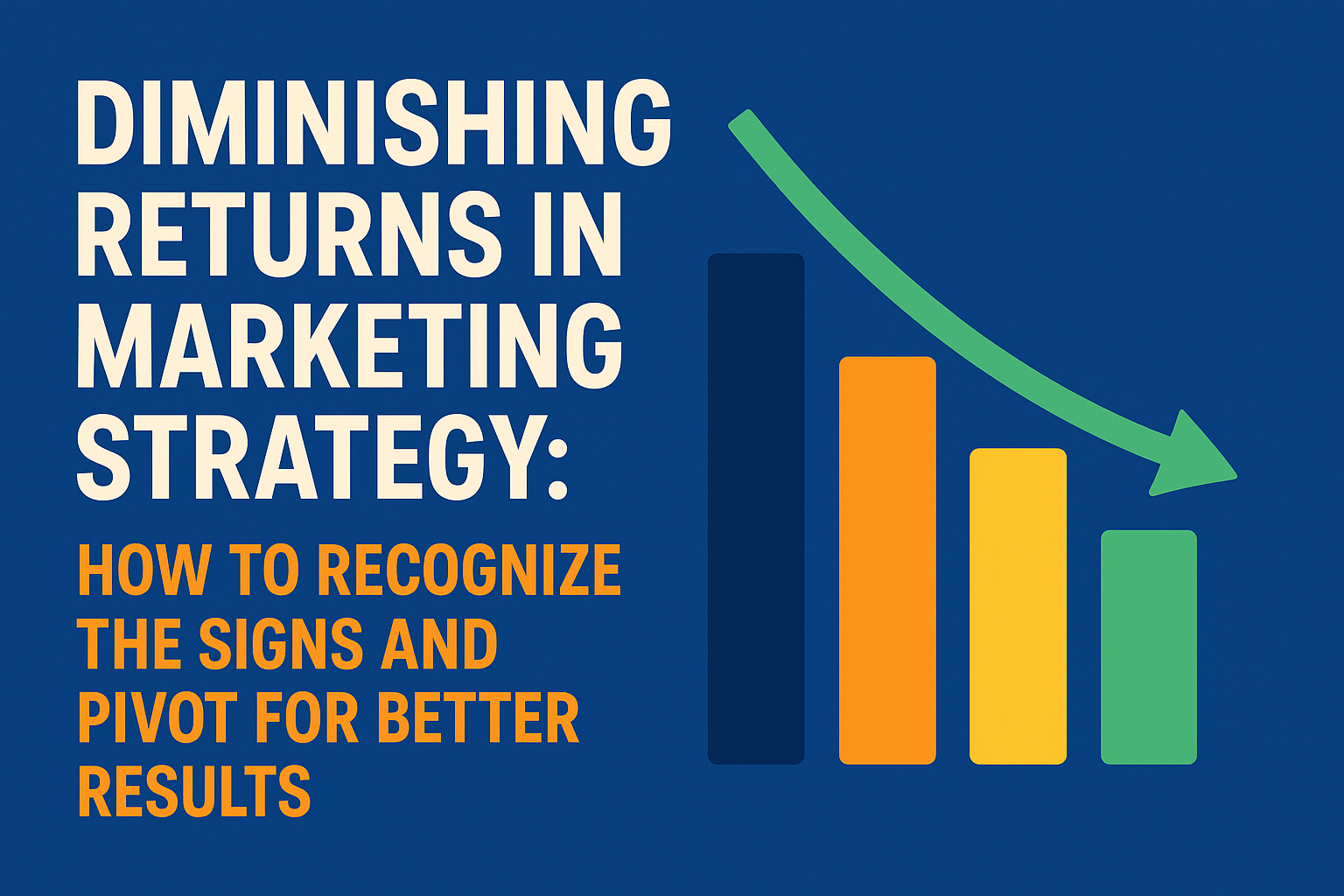By Jo Medico
In an ideal world, every dollar you invest in marketing should yield a consistent—or even increasing—return over time. But any seasoned marketer knows this is rarely the case. Sooner or later, most businesses encounter the issue of diminishing returns in marketing strategy, where additional spending or effort results in less-than-proportional gains. Recognizing this problem early and adjusting your approach can protect your marketing budget and ensure continued business growth.
What Does ‘Diminishing Returns in Marketing Strategy’ Really Mean?
The concept of diminishing returns in marketing strategy originates from economics but is highly applicable in modern digital marketing. In simple terms, it happens when each additional dollar, hour, or resource you invest into a marketing channel produces progressively smaller results. Whether it’s your Google Ads campaigns, social media ads, or SEO efforts, no channel is immune.
For example, let’s say you’ve scaled your Google Ads budget from $5,000 to $10,000 per month. In the beginning, this boost might double your impressions and clicks. However, after a certain point, that extra spend may only marginally increase traffic and not necessarily improve qualified leads or conversions. This is the essence of diminishing returns in marketing strategy: higher effort, lower yield.
Why Do Diminishing Returns Happen?
Several factors contribute to this problem, including:
- Market Saturation
The more you invest in a specific channel or tactic, the quicker you may saturate your target audience. When your prospects have seen your ads or content repeatedly, their responsiveness naturally declines. - Ad Fatigue
Even top-performing ad creatives will eventually wear out their welcome. Without fresh messaging or visuals, audiences stop engaging. - Rising Competition
As your competitors ramp up their marketing efforts, possibly in the exact same channels, you’ll end up paying more for the same results due to increased bidding wars and audience overlap. - Plateaued Audience Reach
Once you’ve reached most of your high-intent audience, additional spend often spills over into lower-quality or less-interested traffic, dragging down performance. - Algorithmic Changes
Platforms like Google and Meta regularly tweak algorithms. What worked yesterday might not perform the same tomorrow, contributing to diminishing returns in marketing strategy.
Warning Signs You’re Hitting Diminishing Returns
How can you tell if your business is suffering from this problem? Watch for these key indicators:
- Flat or Declining Lead Volume Despite Increased Spend
You’re putting more dollars into your campaigns but seeing no real growth in qualified leads or conversions. - Rising Cost Per Acquisition (CPA)
When you notice your cost per lead or sale going up with no clear improvement in customer lifetime value (CLV), it’s a strong signal of diminishing returns. - Lower Engagement Rates
Your CTRs are dropping, bounce rates are climbing, and overall user engagement is waning across paid and organic channels. - Stagnant SEO Traffic
If organic search traffic isn’t growing, even with more content and backlinks, you may have plateaued and need a fresh SEO strategy.
How to Pivot When Facing Diminishing Returns in Marketing Strategy
Recognizing diminishing returns is only half the battle. Here’s how to pivot your marketing strategy effectively:
1. Reallocate Budget Across Channels
If your Google Ads performance is plateauing, try shifting budget to LinkedIn Ads, programmatic display, or influencer partnerships. Multichannel diversification reduces reliance on a single tactic that may be nearing its limits.
2. Refresh Ad Creatives & Messaging
Never let your audience get bored. Regularly A/B test new headlines, visuals, and calls-to-action (CTAs) to maintain interest and engagement. Fresh creative can reignite campaigns showing signs of fatigue.
3. Reevaluate Targeting Parameters
Audience saturation may be to blame. Refine or expand your target demographics, interests, or locations to uncover untapped segments that could deliver better returns.
4. Optimize SEO with Long-Tail Keywords
If your high-competition keywords have stopped driving growth, pivot to less competitive, intent-driven long-tail keywords. This adjustment can capture overlooked but valuable search traffic.
5. Enhance Data Tracking & Reporting
Many businesses misinterpret diminishing returns due to flawed tracking. Use advanced attribution models to reveal which channels or tactics are genuinely underperforming—before you make costly changes.
6. Leverage Expert Partnerships
Sometimes internal teams reach their limit. Partnering with an experienced digital marketing agency, like DoubleDome Digital Marketing, can inject fresh strategy, optimize spend, and break through stagnation.
Why Ignoring Diminishing Returns in Marketing Strategy Is Risky
Failing to recognize or address diminishing returns can drain budgets, lower ROI, and allow competitors to overtake you. It leads to frustrated marketing teams, wasted time, and missed revenue opportunities. As markets, customer behavior, and technologies evolve, your marketing approach must stay agile.
Ready to Break Through Marketing Plateaus?
If your business is experiencing diminishing returns in marketing strategy, it’s time to rethink and refresh your digital marketing efforts. At DoubleDome Digital Marketing, we specialize in creating performance-driven, data-backed strategies that prevent plateaus and unlock sustained growth.
Contact us today for a free marketing audit and discover how we can reignite your results.










